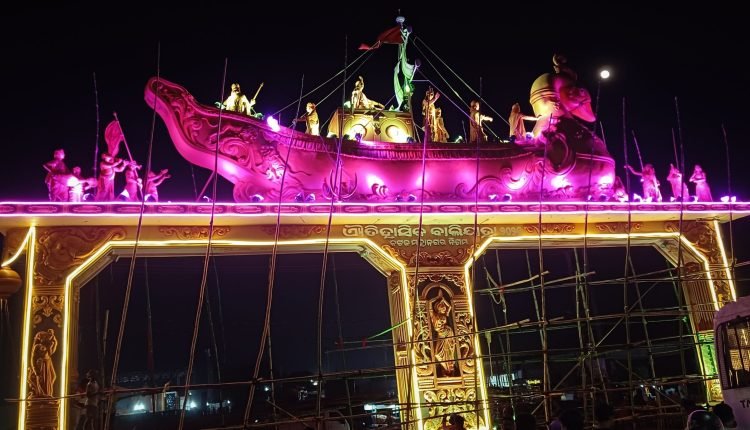Cuttack Welcomes Baliyatra: A Grand Celebration of Odisha’s Maritime Legacy
Asia’s largest open trade fair returns to Cuttack, reviving Odisha’s ancient maritime glory and celebrating the legendary voyages of the Sadhabas across the seas of Kalinga.
Baliyatra Begins on the Banks of the Mahanadi
As the crisp winter breeze sweeps across the river Mahanadi, the historic city of Cuttack is all set to celebrate one of its most revered festivals — Baliyatra. Beginning today, this week-long fair transforms the Gadagadia Ghata into a dazzling spectacle of trade, tradition, and tribute.
Renowned as Asia’s largest open trade fair, Baliyatra attracts lakhs of visitors from across the world every year. But beyond its vibrant lights and colourful stalls, the festival’s spirit lies in its ancient roots — in the stories of Odisha’s brave Sadhabas, the seafarers of Kalinga who once sailed across the seas to distant lands.
Tracing the Origins of Baliyatra
The name “Baliyatra”, derived from the Sanskrit phrase meaning “Voyage to Bali”, commemorates Odisha’s glorious maritime heritage. Historically, the festival was observed on Kartik Purnima, the full moon day of the Hindu month of Kartik, when Odia mariners set sail for trade expeditions to Southeast Asia — particularly to the island of Bali in present-day Indonesia.
These fearless sailors, known as Sadhab Puas, embarked on their journeys more than 2,000 years ago, navigating the monsoon winds in massive wooden boats called Boitas with wide, white Ajhala sails. Their voyages were celebrated in classical literature, such as Sarala Das’s Mahabharata and Kalidasa’s Raghuvamsa, which immortalised them as the “brave sons of Kalinga.”
A Window into Ancient Trade and Exploration
From Bali, Java (Yawadvipa), Sumatra, and Borneo to Sri Lanka, Burma, and even the coasts of Rome and Africa, these ancient traders established a vast network of commerce and culture. Odisha’s exports included spices, textiles, and precious metals, while exotic goods such as ivory, silk, and gems made their way back to the Kalingan shores — enriching both its economy and its culture.
This maritime enterprise turned ancient Odisha into a global hub of trade and cultural diplomacy, long before the rise of modern navigation.
Archaeological Footprints of a Glorious Past
The seafaring legacy of Kalinga is not confined to myth and legend — it is archaeologically verified. Excavations at sites like Manikpatna near Chilika Lake and Tamralipti (modern Tamluk) have unearthed Roman and Kushan coins, Chinese ceramics, and African artefacts, indicating deep trade connections across continents.
Even the famous giraffe sculpture on the Konark Sun Temple points to historical contact with Africa. Ports such as Palur and Pithunda thrived as bustling gateways of commerce, mentioned in ancient records like Ptolemy’s 2nd Geography and Kharavela’s Hathigumpha inscription.
Kalinga’s Global Cultural Footprint
By the 8th century A.D., the influence of Kalinga extended across Southeast Asia, merging into the Sailendra Empire and contributing to the architectural and spiritual development of Java and Bali. The Manjusri-Vastu text codified early architectural forms that influenced temple design in the region.
This era of “Greater India” was also a time of intellectual exchange — monks and scholars like Subhakara shared Buddhist teachings and sutras with China’s Tang dynasty, enriching monasteries such as Nalanda and beyond.
The Odia mariners not only carried goods but also spread language, art, cuisine, and spiritual practices, leaving cultural imprints that still resonate in shared traditions and festivals.
Living Traditions Across the Seas
Echoes of Odisha’s maritime legacy are still alive today in the rituals of Southeast Asia. In Bali’s Masakapan Ke Tukad and Thailand’s Loy Krathong, people float decorated boats with lamps on water — mirroring the Odia custom of Boita Bandana, when miniature boats are set afloat on Kartik Purnima to honour the spirit of the ancient sailors.
These shared practices stand as enduring reminders of a civilisational bond forged by courage, curiosity, and commerce.
Cuttack’s Timeless Connection to the Sea
Every year, as the lights of Baliyatra glow over the Mahanadi, Cuttack transforms into a living museum of Odisha’s past glory. The festival is not merely a fair — it is a celebration of the Odia soul, paying homage to generations of dreamers and explorers who turned the waves into pathways of friendship and prosperity.
With each passing year, Baliyatra continues to remind the world that Odisha’s maritime legacy was not just about trade — it was about building bridges across oceans that still connect hearts, cultures, and histories.



Comments are closed.